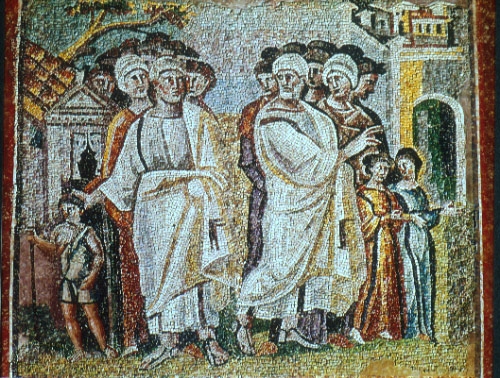
Bereishit יג (Genesis 13)
10 And Lot lifted up his eyes, and beheld all the plain of the Jordan, that it was well watered everywhere, before the LORD destroyed Sodom and Gomorrah, like the garden of the LORD, like the land of Egypt, as you go unto Zoar. 11 So Lot chose him all the plain of the Jordan; and Lot journeyed east; and they separated themselves the one from the other. 12 Abram dwelt in the land of Canaan, and Lot dwelt in the cities of the Plain, and moved his tent as far as Sodom. 13 Now the men of Sodom were wicked and sinners against the LORD exceedingly.
Sodom (סְדֹם) and Gomorrah (עֲמֹרָה) are cities that were allied with Admah, Zeboim, and Bela/Zoar – all together they were referred to as the “cities of the plain.” Sodom and Gomorrah were located on the Jordan River plain in the southern region of Canaan – just on the eastern side of the Dead Sea. This area was well-watered and green which made it suitable for grazing livestock. Sefer Bereishit is the primary source that mentions the cities of Sodom and Gomorrah. The prophets in the Tanakh also referred to Sodom and Gomorrah as a parallel to their prophetic events.
According to the Tanakh the king of Sodom at this time was King Bera and the ruler of Gomorrah was King Birsah. They were not sovereign kings however since they were ruled over by the kingdom of Elam – during the time of Lot under King Chedorlaomer’s rule. Sodom and Gomorrah were under Chedorlaomer’s rule for twelve years but in the thirteenth year of his rule the five kings of the cities of the plain rebelled. In Chedorlaomer’s fourteenth year the battle in the Valley of Siddim led to the defeat of Sodom and Gomorrah which were taken as spoils of war – including many captives (which included Lot). However, Chedorlaomer’s forces were defeated by Abram and his men who pursued them as far as Dan and defeated Chedorlaomer’s forces at Hobah “which is on the left hand of Damascus.”
The archaeological and historical existence of the cities of Sodom and Gomorrah is in dispute since little archaeological evidence has been found in the area of the Dead Sea where these cities are said to have existed in Sefer Bereishit.
Josephus spoke briefly about the war between Chedorlaomer and the five kings of the cities of the plain.
AT this time, when the Assyrians had the dominion over Asia, the people of Sodom were in a flourishing condition, both as to riches and the number of their youth. There were five kings that managed the affairs of this county: Ballas, Barsas, Senabar, and Sumobor, with the king of Bela; and each king led on his own troops: and the Assyrians made war upon them; and, dividing their army into four parts, fought against them. Now every part of the army had its own commander; and when the battle was joined, the Assyrians were conquerors, and imposed a tribute on the kings of the Sodomites, who submitted to this slavery twelve years; and so long they continued to pay their tribute: but on the thirteenth year they rebelled, and then the army of the Assyrians came upon them, under their commanders Amraphel, Arioch, Chodorlaomer, and Tidal. These kings had laid waste all Syria, and overthrown the offspring of the giants. And when they were come over against Sodom, they pitched their camp at the vale called the Slime Pits, for at that time there were pits in that place; but now, upon the destruction of the city of Sodom, that vale became the Lake Asphaltites, as it is called. However, concerning this lake we shall speak more presently. Now when the Sodomites joined battle with the Assyrians, and the fight was very obstinate, many of them were killed, and the rest were carried captive; among which captives was Lot, who had come to assist the Sodomites. (Antiquities of the Jews 1:9:1)1
Strabo states that there were local people near Moasada that attested to cities located along the Dead Sea – of which one was name Sodom.
Many other evidences are produced to show that the country is fiery; for near Moasada are to be seen rugged rocks that have been scorched, as also, in many places, fissures and ashy soil, and drops of pitch that emit foul odours to a great distance, and ruined settlements here and there; and therefore people believe the oft-repeated assertions of the local inhabitants, that there were once thirteen inhabited cities in that region of which Sodom was the metropolis, but that a circuit of about sixty stadia of that city escaped unharmed; and that by reason of earthquakes and of eruptions of fire and of hot waters containing asphalt and sulphur, the lake burst its bounds, and rocks were enveloped with fire; and, as for the cities, some were swallowed up and others were abandoned by such as were able to escape. But Eratosthenes says, on the contrary, that the country was a lake, and that most of it was uncovered by outbreaks, as was the case with the sea. (Strabo: The Geography 6:2:44)2
———————————–
1Whiston, William (trans.). The Works of Flavius Josephus. 1737. [http://sacred-texts.com/jud/josephus/ant-1.htm]
2Jones, H. (trans.). “Strabo: The Geography.” In Loeb Classical Library. Cambridge: Harvard University Press, 1917-1932. [http://penelope.uchicago.edu/thayer/e/roman/texts/strabo/16b*.html]
